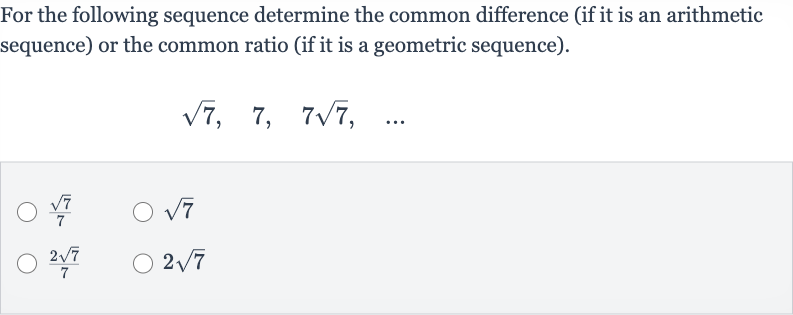Full solution
Q. For the following sequence determine the common difference (if it is an arithmetic sequence) or the common ratio (if it is a geometric sequence).
- Identify type of sequence: Identify the type of sequence by examining the relationship between consecutive terms.
- Check arithmetic sequence: The given sequence is: , , , ... To determine if it's an arithmetic sequence, we need to check if the difference between consecutive terms is constant.
- Calculate difference: Calculate the difference between the second and the first term: .
- Compare differences: Calculate the difference between the third and the second term: .
- Check geometric sequence: Compare the differences. If they are equal, it's an arithmetic sequence; if not, it's not an arithmetic sequence.
- Calculate ratio: The difference between the second and the first term is , which is not a simple rational number.The difference between the third and the second term is , which simplifies to .Since is not equal to , the sequence is not arithmetic.
- Simplify ratio: Now, let's check if it's a geometric sequence by finding the ratio between consecutive terms.
- Calculate ratio: Calculate the ratio between the second and the first term: .
- Simplify ratio: Simplify the ratio:
- Compare ratios: Calculate the ratio between the third and the second term:
- Compare ratios: Calculate the ratio between the third and the second term: . Simplify the ratio: .
- Compare ratios: Calculate the ratio between the third and the second term: . Simplify the ratio: . Compare the ratios. If they are equal, it's a geometric sequence; if not, it's not a geometric sequence.
- Compare ratios: Calculate the ratio between the third and the second term: . Simplify the ratio: . Compare the ratios. If they are equal, it's a geometric sequence; if not, it's not a geometric sequence. Since the ratio between the second and the first term is and the ratio between the third and the second term is also , the sequence is geometric with a common ratio of .
More problems from Function transformation rules
QuestionGet tutor help
QuestionGet tutor help
QuestionGet tutor help
QuestionGet tutor help
QuestionGet tutor help

